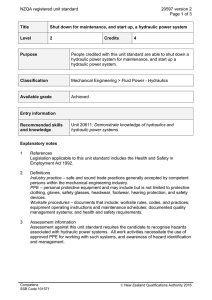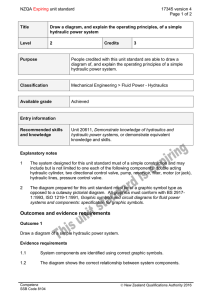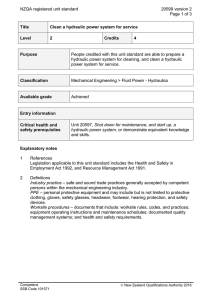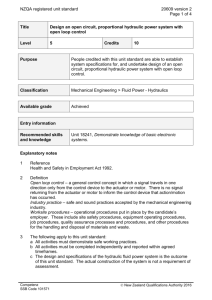NZQA registered unit standard 20611 version 2 Page 1 of 3
advertisement
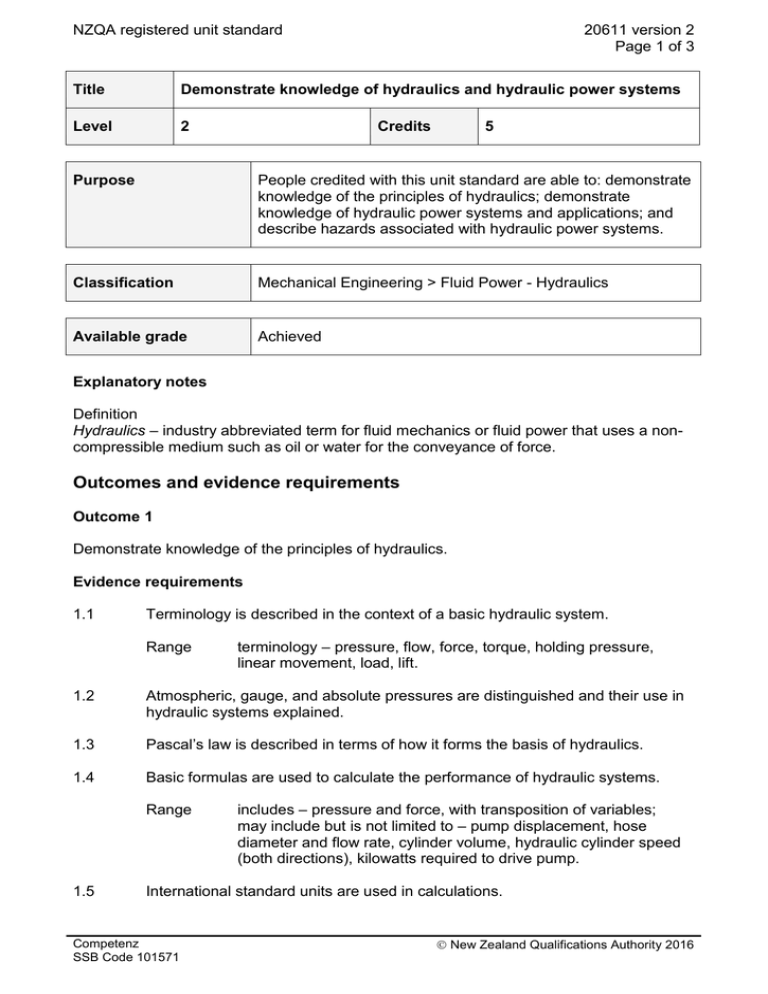
NZQA registered unit standard 20611 version 2 Page 1 of 3 Title Demonstrate knowledge of hydraulics and hydraulic power systems Level 2 Credits 5 Purpose People credited with this unit standard are able to: demonstrate knowledge of the principles of hydraulics; demonstrate knowledge of hydraulic power systems and applications; and describe hazards associated with hydraulic power systems. Classification Mechanical Engineering > Fluid Power - Hydraulics Available grade Achieved Explanatory notes Definition Hydraulics – industry abbreviated term for fluid mechanics or fluid power that uses a noncompressible medium such as oil or water for the conveyance of force. Outcomes and evidence requirements Outcome 1 Demonstrate knowledge of the principles of hydraulics. Evidence requirements 1.1 Terminology is described in the context of a basic hydraulic system. Range terminology – pressure, flow, force, torque, holding pressure, linear movement, load, lift. 1.2 Atmospheric, gauge, and absolute pressures are distinguished and their use in hydraulic systems explained. 1.3 Pascal’s law is described in terms of how it forms the basis of hydraulics. 1.4 Basic formulas are used to calculate the performance of hydraulic systems. Range 1.5 includes – pressure and force, with transposition of variables; may include but is not limited to – pump displacement, hose diameter and flow rate, cylinder volume, hydraulic cylinder speed (both directions), kilowatts required to drive pump. International standard units are used in calculations. Competenz SSB Code 101571 New Zealand Qualifications Authority 2016 NZQA registered unit standard 20611 version 2 Page 2 of 3 Outcome 2 Demonstrate knowledge of hydraulic power systems and applications. Evidence requirements 2.1 The operation of a hydraulic power systems is described with the aid of a simple system diagram sketched by the candidate. Range 2.2 purpose of components, types of fluid medium, compressibility of medium, contamination, precision control, difference between open and closed circuits. Types of equipment powered by hydraulic power systems are identified. Range 2.3 a minimum of two types of equipment. Types of industries where hydraulic power systems are in common use are identified. Range a minimum of four different types of industries. Outcome 3 Describe hazards associated with hydraulic power systems. Evidence requirements 3.1 The characteristics of pressure in hydraulic power systems are described with reference to potential hazards. Range 3.2 motor running, motor stopped, stored energy. Common hazards are described with reference to their potential for personal injury. common hazards – crushing, burns from hot oil at high pressure, fire from oil leaks, flailing hydraulic lines, injection of oil into the skin, oil leaks on floor. Range Planned review date 31 December 2015 Status information and last date for assessment for superseded versions Process Version Date Last Date for Assessment Registration 1 25 May 2004 31 December 2014 Review 2 18 March 2011 N/A Competenz SSB Code 101571 New Zealand Qualifications Authority 2016 NZQA registered unit standard 20611 version 2 Page 3 of 3 Accreditation and Moderation Action Plan (AMAP) reference 0013 This AMAP can be accessed at http://www.nzqa.govt.nz/framework/search/index.do. Please note Providers must be granted consent to assess against standards (accredited) by NZQA, or an inter-institutional body with delegated authority for quality assurance, before they can report credits from assessment against unit standards or deliver courses of study leading to that assessment. Industry Training Organisations must be granted consent to assess against standards by NZQA before they can register credits from assessment against unit standards. Providers and Industry Training Organisations, which have been granted consent and which are assessing against unit standards must engage with the moderation system that applies to those standards. Consent requirements and an outline of the moderation system that applies to this standard are outlined in the Accreditation and Moderation Action Plan (AMAP). The AMAP also includes useful information about special requirements for organisations wishing to develop education and training programmes, such as minimum qualifications for tutors and assessors, and special resource requirements. Comments on this unit standard Please contact Competenz qualifications@competenz.org.nz if you wish to suggest changes to the content of this unit standard. Competenz SSB Code 101571 New Zealand Qualifications Authority 2016
